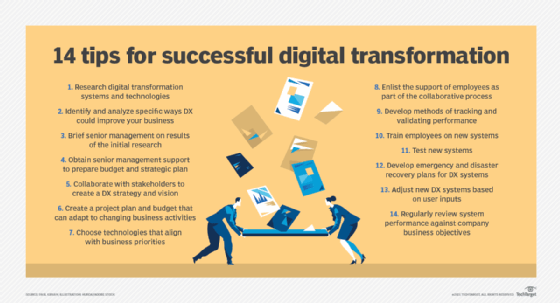digital enterprise
What is a digital enterprise?
A digital enterprise is an organization that uses technology as a competitive advantage in its internal and external operations.
As information technology (IT) has reshaped the infrastructure and operations of enterprises, the digital enterprise evolved to represent businesses that have completed a digital transformation or digitalization to embed digital solutions across the enterprise.
Examples include business processes, products and business models that incorporate digital strategy and digital transformation to compete more effectively in the market.

How does digitalization create a competitive advantage?
A digitalization strategy aims to generate new business opportunities by leveraging globally distributed, digitized assets and organizational resources that help the business to increase efficiency and productivity.
It does this through digitization of assets, automation of business processes and implementation of scalable digital infrastructure.

Digitization of assets
Commonly, the first place this occurs is when physical assets are converted into digital forms that can be collaborated on and shared more easily from person to person and interdepartmentally.
This reduces the time-consuming process of physically searching for or asking where an asset is kept within the organization.
Automation of business processes
Additionally, businesses will leverage tools that empower automation for rules-based, repeatable processes.
Automating workflows can help to increase operational efficiencies, optimize product development and business processes, and improve customer experience.
Digital infrastructure
Finally, scalable infrastructure such as cloud computing, the internet of things (IoT), machine learning through big data and AI are used to serve various business needs and facilitate the functionality of digital tools.
The challenge for digital enterprise
To truly reap the benefits of digitalization, businesses should incorporate the above initiatives across the entire business, from planning to implementation to adoption.
This can be a daunting task as digital transformation touches on all aspects of the enterprise, including business strategy, process redesign, technology selection and organizational change.
However, with careful organization and execution, digital transformation can provide a competitive advantage for increased revenue and profitability. We cover the phases associated with implementing a digital transformation in the next section.

The 5 phases of digital transformation
To ensure that digital transformation across the organization is successful, it is recommended that businesses break down the process into phases. We explore these phases below.
1. Strategy
The digital strategy should be aligned with the overall business strategy and reflect the company's priorities. It should identify how digital solutions can create value for the customer, improve the customer experience and increase the business's ROI and revenue.
2. Process redesign
Once a digital strategy is in place, the next step is to redesign the business processes that will support it. This includes automating workflows where possible and aligning digital solutions with the company's goals.
3. Technology selection
After the processes have been redesigned, the next step is to select the right technology tools to support them. This includes evaluating which digital platforms and tools will be the most efficient and effective for the company's needs.
4. Implementation
The final phase is to implement the digital solutions across the organization. This includes training employees on the new systems, integrating the digital solutions with legacy systems and resolving any issues during the transition period.
5. Adoption
Once the digital solutions are up and running, it is essential to encourage employee adoption. This means providing the right tools and training so that employees can quickly and easily adopt the new systems into their daily work.
The success of digital transformation depends on careful planning and execution across all five phases. By following these best practices, businesses can ensure a successful digital transformation.
See also: 14 need-to-know tips for digital transformation success, how to measure and improve digital transformation ROI and 10 must-read digital transformation books.







